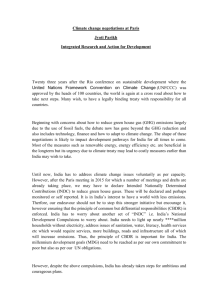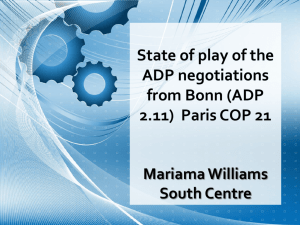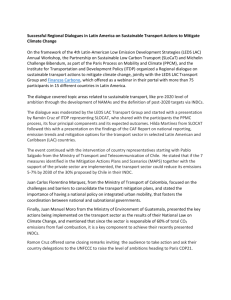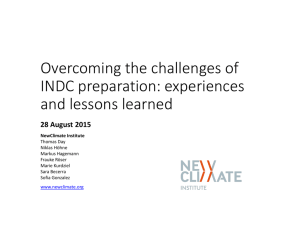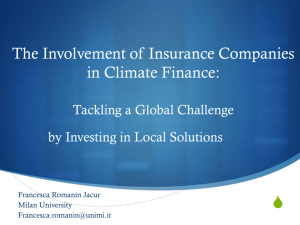experiences and lessons learned
advertisement
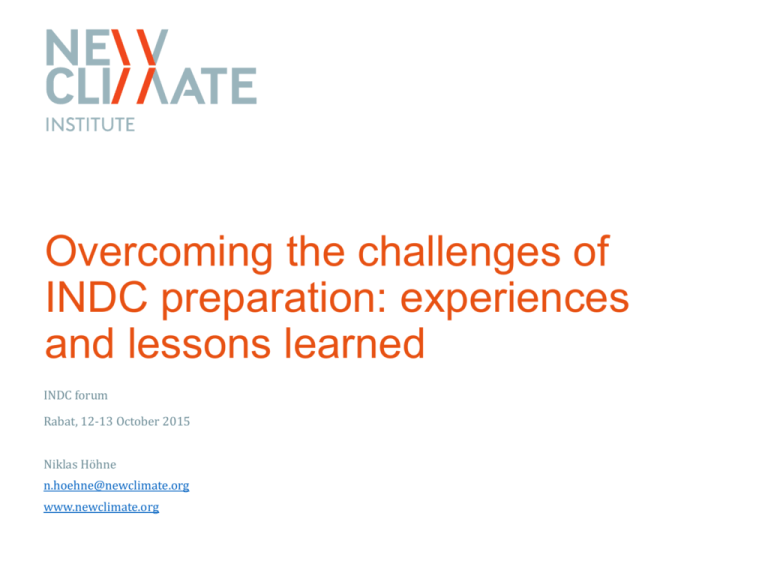
Overcoming the challenges of INDC preparation: experiences and lessons learned INDC forum Rabat, 12-13 October 2015 Niklas Höhne n.hoehne@newclimate.org www.newclimate.org Introduction Received and planned submissions 119 submissions, representing 147 Parties, representing over 85% of total global GHG emissions Before Paris: 92% of emissions expected Source: http://files.newclimate.org/indc-preparation-progress/, NewClimate Institute survey for UNFCCC and UNDP www.newclimate.org 2 What can be learned from experiences in other countries? Experiences and lessons learned 1. What to include in INDCs (Lack of certainty on what to be included in INDCs, 71%) 2. How to mitigate limited capacity (Limited expertise for assessing mitigation options, 71%) (Too short timeframes for undertaking processes, 88%) 3. How to secure broad participation and support (Securing high-level political support, 61%) (Lack of understanding in other sectors/ ministries, 59%) Challenge for x% of the consulted countries www.newclimate.org 3 Opportunities in the preparation of INDCs • Consolidated and accelerated climate change policy processes • Mainstreaming climate into other policy making processes • From planning to implementation “Acceleration of national climate change policy process” “Improved national processes” • Enhanced stakeholder engagement “Enhanced engagement of stakeholders in climate change planning” “Improved domestic communication between government, CSO and public” • Improved data and information management • Enhanced south south cooperation www.newclimate.org 4 Attachments Further reading Full presentation report on lessons learned from INDC preparation: Attached below, http://newclimate.org/2015/08/31/overcoming-the-challenges-of-indcpreparation-experiences-and-lessons-learned-2/ Sum Climate Action Tracker update of 1 October 2015 – INDCs so far leading to 2.7°C: http://climateactiontracker.org/assets/publications/CAT_global_temperature_up date_October_2015.pdf Nat io synt h of 11 wit h t prom annou Assessing the missed co-benefits of INDCs – Jobs, reduced fossil fuel imports and reduced premature deaths from air pollution: http://newclimate.org/2015/03/27/indc-cobenefits/ The impact of good practice policies on global greenhouse gas emissions: http://newclimate.org/2015/07/29/the-impact-of-good-practice-policies-onregional-and-global-greenhouse-gas-emissions/ 2030 ref lec wher availa result about There is st ill a large emission For 1.5°C t he 2025 gap improvement in t he level of m Wit h current INDCs, t he emis There is a major risk t hat if st rengt hened every f ive year by all t he most vulnerable c f undament ally t hreat ened. Of t he 19 INDCs rat ed by t h been rat ed as “suf f icient .” I “medium,” and eight , which suf f icient but cover only 0.4 inf ormat ion. www.newclimate.org 6 Based on t he climat e act ion t he Paris climat e conf erence Overcoming the challenges of INDC preparation: experiences and lessons learned 13 August 2015 NewClimate Institute Thomas Day Niklas Höhne Markus Hagemann Frauke Röser Marie Kurdziel Sara Becerra Sofia Gonzalez www.newclimate.org This presentation report was prepared by NewClimate Institute on behalf of the United Nations Framework Convention on Climate Change (UNFCCC) and the United Nations Development Project (UNDP), under the project Experiences and lessons learned in the preparation of INDCs. The contents express the views of the authors and participating country representatives, and do not necessarily represent the views of the UNFCCC or UNDP. The country-level data and information contained in this document are based upon publically available information, and information provided by country representatives for the purpose of this research activity. Usage rights: Unlimited re-use of this presentation report for all purposes is allowed only in its current format, without changes made to content or design. Usage of information in this document is allowed when cited. www.newclimate.org 8 Abbreviations BUR Biennial Update Report CDM Clean Development Mechanism GHG Greenhouse gas INDC Intended Nationally Determined Contribution LEDS Low Emissions Development Strategy NAMA Nationally Appropriate Mitigation Action NAP National Adaptation Plans TNA Technology Needs Assessment UNFCCC United Nations Framework Convention on Climate Change www.newclimate.org 9 Contents Introduction 5 Challenge: What to include in INDCs 9 1.1 What types of mitigation commitments are countries using in their INDCs? 1.2 What is the typical format of mitigation commitments in INDC documents? 1.3 How are different countries including adaptation in their INDCs? 11 14 16 Challenge: Mitigating limited capacity 20 2.1 How are countries determining their sectoral scope? 2.2 How are countries building upon their existing knowledge and processes? 2.3 How can an assessment of co-benefits inform the design of an INDC? 2.4 How can the split between unconditional and conditional contributions be determined? 2.5 What are the best practices for the assessment of equity and ambition? Challenge: Securing broad participation and support 21 23 27 29 31 34 3.1 How have countries obtained and benefited from high-level support 3.2 How have countries ensured cross-ministerial coordination? 3.3 What are good practices for INDC stakeholder consultation? 35 36 37 Opportunities 39 www.newclimate.org 10 Introduction Context The global challenge: Achievement of an ambitious global climate agreement at COP21 The national challenge: Development of Intended Nationally Determined Contributions (INDCs) Objective of this presentation Enable knowledge sharing, peer-to-peer learning and identification of good practices for INDC preparation through analysis of approaches and progress worldwide. Methodology: 1) Collection of information through online surveys and detailed interviews 2) Analysis of information to distil lessons learned and relevant knowledge for international processes 3) Multiple knowledge sharing activities Statistics: • Data collected from 125 countries; updated monthly from February to July 2015 • 44 detailed interviews with high-level country representatives • Coverage includes countries from all regions and levels of economic development www.newclimate.org 11 Introduction Challenges in the preparation of INDCs Countries report 5 major challenges: “Too short timeframes for undertaking processes” (88%) “Lack of certainty on what to be included in INDCs” (71%) “Limited expertise for assessing mitigation options” (71%) “Securing high-level political support” (61%) “Lack of understanding in other sectors/ ministries” (59%) www.newclimate.org 12 Introduction Opportunities in the preparation of INDCs Countries report opportunities: “Improved international communication” “Enhanced engagement of stakeholders in climate change planning” “Acceleration of national climate change policy process” “Improved national processes” “Improved domestic communication between government, CSO and public” www.newclimate.org 13 Introduction What can be learned from experiences in other countries? Experiences and lessons learned 1. What to include in INDCs (Lack of certainty on what to be included in INDCs) 2. How to mitigate limited capacity (Limited expertise for assessing mitigation options) (Too short timeframes for undertaking processes) 3. How to secure broad participation and support (Securing high-level political support) (Lack of understanding in other sectors/ ministries) 4. What benefits can be gained from the INDC process? www.newclimate.org 14 1. What to include in INDCs Barrier Lack of certainty on what to be included in INDCs 0% 25% 50% 100% 75% (based on responses from 44 countries) Topics covered • What types of mitigation commitments are countries using in their INDCs? • What is the typical format of mitigation commitments in INDC documents? • How are different countries including adaptation in their INDCs? www.newclimate.org 15 Challenge: What to include in INDCs 1 What can we learn from existing INDC submissions? Overview of existing submissions Coverage: Countries cover a range of regions and income levels. INDC types: Most are based on economy-wide GHG targets; less than half of all Parties are eventually expected to include these. Mitigation and adaptation: All focus primarily on mitigation; of 22 INDC submissions, 13 have included adaptation; EU and US have submitted separate documents on adaptation; over 50% of countries are expected to include an adaptation component. Conditional INDCs: Mexico’s and Morocco’s INDCs are existing examples that include both an unconditional and a conditional contribution. For Ethiopia, the distinction between supported and unsupported elements will come at a later stage. www.newclimate.org 16 Challenge: What to include in INDCs 1.1 Type of mitigation contributions Existing mitigation contributions Party INDC Type (mitigation) Target Ref. Point Andorra Sectoral GHG target - BAU 37% GHG reduction by 2030 BAU Canada Economy-wide GHG target – BY China Decarbonisation indicator Ethiopia Economy wide GHG target – BAU 30% GHG reduction by 2030 2005 Reduce emissions intensity of GDP by 60-65% 2005 by 2030 64% GHG reduction by 2030 BAU EU Economy-wide GHG target - BY 40% GHG reduction by 2030 1990 Gabon Economy wide GHG target - BAU 50% GHG reduction by 2025 BAU Iceland Economy-wide GHG target - BY 40% GHG reduction by 2030 1990 Japan Economy-wide GHG target - BY 26% GHG reduction by 2030 2013 Kenya Economy-wide GHG target - BAU 30% GHG reduction by 2030 BAU Liechtenstein Economy-wide GHG target - BY 40% GHG reduction by 2030 1990 Table 1 (Page 1/2): Overview of existing submissions + = Unconditional contribution Summary of INDCs submitted by June 11 2015 BY = target is relative to a Base Year BAU = target is relative to a Business As Usual trajectory ++ = Conditional contribution www.newclimate.org 17 Challenge: What to include in INDCs 1.1 Type of mitigation contributions Existing mitigation contributions Party INDC Type (mitigation) Target Ref. Point Marshall Islands Economy-wide GHG target - BY 32% GHG reduction by 2025 2010 Mexico Economy-wide GHG target - BAU 25%+ / 40%++ GHG & SLCP reduction by 2030 BAU Monaco Economy-wide GHG target - BY 50% GHG reduction by 2030 1990 Morocco Economy wide GHG target - BAU 13%+ / 32%++ GHG reduction by 2030 BAU New Zealand Economy-wide GHG target - BY 30% GHG reduction by 2030 2005 Norway Economy-wide GHG target - BY 40% GHG reduction by 2030 1990 Republic of Korea Economy-wide GHG target - BAU 37% GHG reduction by 2030 BAU Russia Economy-wide GHG target - BY Limit GHGs to 70-75% by 2030 1990 Serbia Economy-wide GHG target - BY 1990 Singapore Decarbonisation indicator 9.8% GHG reduction by 2030 Reduce emissions intensity of GDP by 36% by 2030 2005 Table 1 (Page 2/2): Overview of existing submissions + = Unconditional contribution Summary of INDCs submitted by June 11 2015 BY = target is relative to a Base Year BAU = target is relative to a Business As Usual trajectory ++ = Conditional contribution www.newclimate.org 18 Challenge: What to include in INDCs 1.1 Type of mitigation contributions Existing mitigation contributions Economy-wide GHG target – BY Type of mitigation contribution Most existing submissions are from industrialised countries Economy wide GHG target – BAU Sectoral GHG target - BAU OECD Decarbonisation indicator Europe (non-OECD) Policies and measures Asia and Pacific (nonOECD) Figure 1: Type of contribution in existing INDCs Most existing submissions include economy wide GHG targets, although are expected to use this approach Africa (non-OECD) Regional coverage Latin America and Caribbean (nonOECD) Figure 2: Regional coverage of existing INDCs www.newclimate.org 19 Challenge: What to include in INDCs 1.2 Format of mitigation contributions Format and content of submissions as to mitigation: Elements: Most existing submissions include a number of the same elements • Key information on the INDC (summary, ref. point, scope and coverage, methodological details) is included in all submissions. • Other elements are found in most submissions. Typical level of detail: Short, concise information. Ca. 5 pages in total. Typical format: Highlighted summaries followed by details in tabular format (e.g. EU, Norway, Switzerland, Mexico, Russia). www.newclimate.org www.newclimate.org 20 20 Challenge: What to include in INDCs 1.2 Format of mitigation contributions Format component commonly included in existing submissions Examples Concise 1 sentence summary of the target Liechtenstein, EU, US, Switzerland Reference point Andorra, Mexico and Gabon for BAU Scope and coverage EU, Norway, US, Russia Methodological approaches including LULUCF EU Further technical details of the INDC EU Long-term goals, stated but not major focus Norway, US, Mexico Legislative planning process Russia, Norway Fairness, ambition and convention objective See section 1.4 Additional conditional contribution Mexico, Morocco (see section 2.5) Finance requirements Gabon Adaptation component Mexico, Morocco, Ethiopia and Gabon Gender considerations Mexico Table 2: Major elements included in existing INDCs and useful examples for their formatting. See Notes for details www.newclimate.org 21 Challenge: What to include in INDCs 1.3 How are different countries including adaptation in their INDCs? Countries were asked to indicate whether they agree or disagree that adaptation plans would form a major component of their INDC: (based on responses from 159 countries) www.newclimate.org 22 Challenge: What to include in INDCs 1.3 How are different countries including adaptation in their INDCs? Format and content of submissions as to adaptation: • Some countries consider the adaptation component to be on equal footing with the mitigation component; however, most countries focus on mitigation and secondly on adaptation in their INDCs. • Countries follow very different approaches with regard to format and contents of the adaptation component of their INDCs. Format: addressed in single chapter (and sub-chapters); integrated into tabular format; included in annex; included in NatCom; separate document on adaptation Elements: long- and short-term goals (qualitative or quantitative); long- and shortterm actions; strategies; policies/ programmes; action plans; monitoring and evaluation systems; investment estimates; international support www.newclimate.org www.newclimate.org 23 23 Challenge: What to include in INDCs 1.3 How are different countries including adaptation in their INDCs? Party Format Elements Focus China Chapter in INDC text Adaptation strategy; intern. support M&A Ethiopia Chapter/ sub-chapters in INDC table Long-term goal (qual); short- and long-term actions; M&E M&A Gabon Chapter in INDC text Adaptation strategy M Kenya Chapter in INDC text Long-term goal (qual); NAP; sector-specific goals & actions A Marshall Islands Ref in INDC table (short)/ annex (long) Adaptation framework; adaptation plan; intern. support M Mexico Ref in INDC table (short)/ annex (long) Sector-specific goals & actions, intern. support M&A Monaco Chapter in INDC text Adaptation strategy; adaptation action plan M Morocco Chapter/ sub-chapters in INDC text Long-term goals (quan); sector-specific goals & actions; investment estimation; M&E; intern. support M&A Serbia Ref in INDC table Sector vulnerability; investment estimation M Singapore Ref in INDC table (short)/ annex (long) Sector-specific goals & actions M South Korea Chapter in INDC text Adaptation plan; sector-specific actions (short) M EU Separate document Adaptation strategy; sector-specific actions; lessons learnt M New Zealand Reference to 6th National Communication Adaptation policies; sector-specific actions M Norway Reference to 6th National Communication Adaptation framework; sector-specific actions M United States Separate document U.S. domestic and international adaptation priorities M www.newclimate.org 24 Challenge: What to include in INDCs Where is further information and guidance available? See also… Höhne, Ellermann & Fekete (2014) Process guidance for Intended Nationally Determined Contributions (INDCs). http://newclimate.org/2014/12/06/process-guidance-on-indcs-prepared-bynewclimate-staff-4/ WRI (2015) Designing and Preparing Intended Nationally Determined Contributions (INDCs). http://www.wri.org/publication/designing-and-preparing-indcs PMR (2015) Checklist on Establishing Post-2020 Emission Pathways. https://www.thepmr.org/content/checklist-establishing-post-2020-emission-pathways CDKN & Ricardo-AEA (2015) A guide to INDCs. http://cdkn.org/wp-content/uploads/2015/04/CDKN-RicardoAEA-Guide-to-INDCs_FINAL_WEB1.pdf Website resources from the International Partnership for Mitigation and MRV. http://www.mitigationpartnership.net/intended-nationally-determined-contributions-indcs www.newclimate.org www.newclimate.org 25 25 2. Mitigating limited capacity Barriers Limited technical expertise for assessing mitigation options 0% 25% 50% 100% 75% Too short timeframes for undertaking processes 0% 25% 50% 100% 75% (based on responses from 44 countries) Topics covered • How are countries determining their sectoral scope? • How are countries building upon their existing knowledge and processes? • How can an assessment of co-benefits inform the design of an INDC? • How can unconditional and conditional contributions be determined? • What are the best practices for the assessment of equity and ambition? www.newclimate.org 26 Challenge: Mitigating limited capacity 2.1 How are countries determining their sectoral scope? Not all Parties have the resources and/or capacities to determine appropriate economy-wide contributions in this first INDC round. How are countries determining their sectoral scope? Figure 5: Criteria that countries have used to prioritise sectors for their INDCs Sector prioritisation practices Potential impact Synergies/continuity Emissions reduction potential Common mitigation and adaptation goals Accrual of wider economic and social co-benefits National priorities Other national climate change processes www.newclimate.org www.newclimate.org 27 27 Challenge: Mitigating limited capacity 2.1 How are countries determining their sectoral scope? Examples of practices for scope selection and sector prioritisation Potential impact Synergies/continuity Emission reduction potential Common mitigation and adaptation goals Assessment through use of existing data and processes • Thailand: Major synergies between adaptation and mitigation • Philippines: Vulnerability of mitigation options assessed (see section 2.2) • Chile & Peru: Mitigation Action Plans and Scenarios (MAPS) Co-benefits assessment Making a case for sectoral action National priorities Using the INDC to accelerate the implementation of other national priorities • Senegal: Electrification & reduced consumption of dirty fuels • Uganda: Focus on forestry and energy to align with national development priorities • Solomon Islands: Sustainable Development Goals (SDGs) (see section 2.3) • Dominican Republic: Quantified jobs, economic impact and other benefits • Colombia: extensive co-benefit analysis under the Colombian Low Carbon Development Strategy (ECDBC), which is a key input for the INDCs. Figure 6: Examples of practices for scope selection and sector prioritisation. See Notes for details www.newclimate.org www.newclimate.org 28 Challenge: Mitigating limited capacity 2.2 How are countries building upon their existing knowledge and processes? Potential links of INDCs with other national climate change processes Most countries use existing documents as data sources for their INDC development: • National Communications (e.g. Morocco) • National Inventories Other CDM NAMA LEDS National Communications National Inventories Some countries build upon ongoing national climate change processes to compile and communicate their INDC: • Low Emissions Development Strategies - LEDS (e.g. Colombia) • Nationally Appropriate Mitigation Actions - NAMAs (e.g. Thailand) • Clean Development Mechanism - CDM (e.g. Vietnam) Figure 7: Examples of practices for links of INDCs with other national climate change processes. See Notes for details www.newclimate.org www.newclimate.org 29 Challenge: Mitigating limited capacity 2.2 How are countries building upon their existing knowledge and processes? Use of existing data and processes: Dominican Republic Dominican Republic CNCCMDL • TNC/BUR INDC LEDS (CCDP) Energy Transport Forestry CDM – PoA – NAMA • Quick wins • Inter-ministerial coordination: National Council for Climate Change and Clean Development Mechanism (CNCCMDL) Legal framework: National Development Strategy (NDS) 2030 Framework for action: Climate Compatible Development Plan (CCDP) Figure 8: Links of the Dominican Republic’s INDC with other national climate change processes. See Notes for details www.newclimate.org www.newclimate.org 30 Challenge: Mitigating limited capacity 2.2 How are countries building upon their existing knowledge and processes? Use of existing data and processes: Peru NAMAs MAPS PlanCC INDC 5 June. Start consultation process • • • BUR Forest projects and Forest Investment Program (PIF) Plans and programs 58 mitigation actions across 6 sectors 31% reduction of emissions for 2030 against BAU scenario 82.2 mtCO2eq reduction by 2030 17 July. End consultation process and revision of draft INDC 31 August. Country presents INDC to the UNFCCC Figure 9: Use of existing data and processes in Peru. See Notes for details www.newclimate.org www.newclimate.org 31 31 Challenge: Mitigating limited capacity 2.2 How are countries building upon their existing knowledge and processes? Review and revision of existing targets Embedding the INDC into a Review and Revision process of existing policy targets is more efficient and more effective than beginning new processes. “Indonesia’s INDC is a by-product of the Indonesia Mitigation Policy review process” 2015 - BAPPENAS, 2015 2030 • • • • • Beyond Continued review and revision of institutionalised climate change policy / INDC Ensure integration of INDC in national policy Reduce burden of undertaking new analysis from start Established roles and responsibilities Experience and evidence to reduce uncertainty Understand the implications of policy implementation Figure 10: Review and revision of existing targets in Indonesia. See Notes for details www.newclimate.org www.newclimate.org 32 32 Challenge: Mitigating limited capacity 2.3 How can an assessment of co-benefits help to inform the design of an INDC? Co-benefit assessment Cost savings from fossil fuel imports, improved energy security, health from reduced air pollution, job creation, traffic decongestion, economic development etc. • Make a case for prioritizing sector and measures to include in the INDC. • Increase the willingness of decision makers and stakeholder to increase ambition. Figure 11: Infographic on co-benefit assessment in the US, the EU and China . See Notes for details www.newclimate.org www.newclimate.org 33 33 Challenge: Mitigating limited capacity 2.3 How can an assessment of co-benefits help to inform the design of an INDC? The Dominican Republic quantified the non-GHG related benefits for specific measures in all sectors, in order to inform the design of the INDC. (see energy and transport, for example, in Figure #) Sector/measure Job creation in 2013 Economic impacts (mUSD/a) GHG emission reduction (MtCO2e/a) Energy 34,300 1,000 8.6 Substitute all fuel-oil plants with gas Reduce inefficient auto generation from 25% to 5% Increase share of renewable energy to 38% Energy efficiency: reduce energy demand 13% 1,300 33,000 130 20 300 550 1 0.5 4.3 2.8 Transport 25,000 1,700 5.3 Establish efficiency standards Shift to CNG Increase consumption of biofuels Scale-up public transport 4,000 21,000 - 500 600 400 200 1.3 1.1 2.4 0.5 Other non-GHG benefits Cleaner air Cleaner air, black carbon reduction, less traffic congestion Table 3: Assessment of co-benefits of proposed actions in Dominican Republic. Source: Alvarez (2015) www.newclimate.org www.newclimate.org 34 34 Challenge: Mitigating limited capacity 2.4 How can unconditional and conditional contributions be determined? Determining contributions - using existing and planned policies and strategies Morocco 3 measures from UNDP FOCAM excercise 10 measures in place from forthcoming 3rd NC Dialogue on forestry CDM pipeline Emission level in 2025/ 2030 Ecuador Unconditional INDC Conditional INDC 54 measures the country could potentially implement as identified in 3rd NC Figure 3: Determining contributions using policies and strategies. See Notes for details www.newclimate.org www.newclimate.org 35 35 Challenge: Mitigating limited capacity 2.4 How can unconditional and conditional contributions be determined? Determining contributions top down Emissions in 2025/ 2030 Identifying what you should do and what you could do can help you in determining your contributions. Unconditional INDC “Fair” contribu tion Mitigation potential Conditional INDC “Fair” contribution Mitigation potential Question to ask : “What level of emissions should I achieve to make a fair and equitable contribution?” Question to ask: “What level of emission reductions could I achieve given the mitigation potential in my county ?” How: Effort sharing approaches How: National mitigation potential analysis (e.g. MACC) Figure 4: Determining contributions top down. See Notes for details www.newclimate.org www.newclimate.org 36 36 Challenge: Mitigating limited capacity 2.5 What are the best practices for the assessment of equity and ambition? Ways to compare mitigation efforts • Effort sharing What is the “fair” share? How much should emissions be reduced? • Potential How much could emissions be reduced (irrespective of who pays)? • Comparison to benchmarks for decarbonisation indicators How are other countries developing? • Good practice policy packages What are other countries doing? www.newclimate.org www.newclimate.org 37 37 Challenge: Mitigating limited capacity 2.5 What are the best practices for the assessment of equity and ambition? Ambition and equity in INDCs so far Country States to be in line with IPCC trajectories In line with own long term target Ambitious because a deviation from trend Mentions per capita emissions EU X X Liechtenstein X X Andorra X X X Switzerland Norway USA Canada Mentions small contribution to world total Mentioni ng peak year X X X X X X X X Russia X Mexico X X X Morocco X X X Ethiopia Mentiones reduction in emissions per GDP X X www.newclimate.org www.newclimate.org 38 38 Challenge: Mitigating limited capacity 2.5 What are the best practices for the assessment of equity and ambition? Examples: MAPS countries • Integrated in the INDC preparation methodology: Determine “required by science scenarios” for comparison with mitigation potential “Required by science scenario” Source: MAPS Chile: http://mapschile.cl/files/resumen_MAPSChile_Fase2_102014.pdf • Received limited attention in the beginning • But is used in the final stages of the INDC preparation as a validation step, that may nudge the INDC a bit further www.newclimate.org www.newclimate.org 39 39 3. Securing broad support Barriers Securing high-level political support 0% 25% 50% 100% 75% Lack of understanding in other sectors/ ministries 0% 25% 50% 100% 75% (based on responses from 44 countries) Topics covered • How have countries obtained and benefited from high-level support? • How have countries ensured inter-ministerial coordination? • What are good practices for INDC stakeholder consultation? www.newclimate.org 40 Challenge: Securing broad participation and support 3.1 How have countries obtained and benefited from high level support? Mandate and level of sign-off for INDCs In most countries, the mandate to begin preparations for an INDC came from the Ministry in which the UNFCCC focal point is based. Only a quarter of countries expected to require sing-off from parliament or the head of state, at the start of the INDC process. Which level of governance, is responsible for the final sign-off of the INDC submission? - Asked March 2015 Political processes for INDC preparation may have been underestimated by a lot of countries. Figure 12: Required level of sign-off forecast by countries www.newclimate.org www.newclimate.org 41 41 Challenge: Securing broad participation and support 3.1 How have countries ensured cross-ministerial coordination? Many countries have difficulties to engage all governmental bodies. Some countries overcame this barrier through: • New, formally established interministerial processes or committees, dedicated to the INDC, with a leading (steering) role • Use of existing inter-ministerial processes • Distribution of key responsibilities between ministries • Intensive training seminars for deputyministers “The establishment of an inter-ministerial steering committee dedicated to the INDC process, ensured maximum participation and understanding across all relevant governmental bodies” - Georgia www.newclimate.org www.newclimate.org 42 42 Challenge: Securing broad participation and support 3.3 What are good practices for INDC stakeholder consultation? Why stakeholder involvement? • • • Secure broad level buy-in and public support for policies (e.g. Armenia) Provision of specific information, data, and new ideas as well as new skill sets Mobilisation of key actors for later implementation process Who to involve? • • • Broad range of stakeholders from government, civil society, academia and private sector (e.g. Chile, Senegal) Potentially focus on specific key stakeholder groups depending on focus of the INDC (e.g. private sector in Singapore) Inclusion of local and regional government (e.g. Uganda, Kenya) How to manage the process? • • • Careful planning of timing and degree of involvement is essential Transparency on process and use of stakeholder inputs Consultation methods may differ: bilateral, multilateral or online www.newclimate.org www.newclimate.org 43 43 Challenge: Securing broad participation and support 3.3 What are good practices for INDC stakeholder consultation? Two country examples on how to engage stakeholders successfully. SINGAPORE ARMENIA WHY? - Specific inputs and expertise WHY? - Public awareness and buy-in WHO? - Focus on private sector WHO? - Focus on general public HOW? - Use of an online platform open for comment for 10 weeks - Dialogue sessions co-organised with key stakeholder groups, mainly business associations HOW? - Public opinion survey on INDC themes through media outlet - Organised 10 thematic roundtables with senior government officials - Discussions were broadcasted to general public www.newclimate.org www.newclimate.org 44 44 4. Opportunities “Improved international communication” “Enhanced engagement of stakeholders in climate change planning” “Acceleration of national climate change policy process” “Improved national processes” “Improved domestic communication between government, CSO and public” 0% 25% 50% 100% 75% Topics covered • Developing the national climate change agenda • Improving collection and coordination of information www.newclimate.org 45 Opportunities 4.1 Developing the national climate change agenda Consolidation of existing climate change processes In some countries without previous formal climate targets, the variety of national, subnational and donor driven climate activities may be fragmented. See section 2.2 for further details on process consolidation For some, the INDC has provided an impetus to consolidate fragmented activities: • Senegal has consolidated NAP, TNA, LEDS, NAMAs, CDM, national policies and national strategy documents • In the Dominican Republic the INDC strongly builds upon multiple national climate change processes such as CNCCMD, NAMAs and the CDM (see section 2.2) Result: Resource efficiency gains, improved strategic planning, identification of synergies between efforts www.newclimate.org www.newclimate.org 46 46 Opportunities 4.1 Developing the national climate change agenda Acceleration of existing climate change processes 75% of countries report that the INDC process has helped to accelerate existing processes. Completion of existing processes required as input LEDS process in Georgia given renewed priority since its comprehensive analysis on mitigation options and scenarios will be the main input to the INDC design. Increased attention and awareness for climate change activities Armenia developed a “relationship and a common understanding” with the public, helping to accelerate the implementation of grassroots mitigation and adaptation measures. Priority stimulus to overcome barriers common to INDC and other processes The INDC in Thailand has made the sectoral plans more visible for relevant government agencies and thus has developed a a more supportive political environment, also for other indirectly related processes . www.newclimate.org www.newclimate.org 47 47 Opportunities 4.1 Developing the national climate change agenda Mainstreaming climate change in policy Some countries report tangible improvements in consideration of climate change issues in ministries usually unconcerned in climate policy making. • In Georgia the inter-ministerial led INDC process has assigned responsibilities across various ministries, many of whom are becoming engaged with climate change related responsibilities for the first time. • In Thailand the INDC process has highlighted the efforts on climate change that the different ministries had previously included in their sectoral plans. www.newclimate.org www.newclimate.org 48 48 Opportunities 4.1 Developing the national climate change agenda Progressing from planning to implementation For some countries, where implementation has thus far been limited, the INDC may catalyse a progression from planning to implementation: Recent years: Planning with limited implementation Many countries have been especially active in their climate change planning activities in recent years. Planning 2015: INDC submission INDC’s prepared with formal implementation timeframe INDC Beyond 2015: Implementation INDC’s implementation timeframe provide an enhanced focus on the development and execution of implementation plans. • Implementation In Thailand, for example, the INDCs will provide more specific actions for implementation of the energy plan of the Ministry of Energy. www.newclimate.org www.newclimate.org 49 49 Opportunities 4.1 Developing the national climate change agenda Enhanced engagement of stakeholders See section 3.3 for further details on stakeholder consultation Broad coverage and important implications of INDCs necessitates the participation of wide stakeholder groups. ↓ INDC preparation provided the stimulus to broaden the stakeholder consultation base, with benefits. (Approx. 80% of countries report benefiting from improved stakeholder consultation) ↓ • Singapore - major participation from business, CSO and academia – uncovered ideas and skill sets not previously available to the government. • Georgia – consideration of embassies as a major stakeholder for the first time – uncovered opportunities for support and improved international dialogue. www.newclimate.org www.newclimate.org 50 50 Opportunities 4.2 Improving collection and co-ordination of information Information and data management Access to data and information from various sectors and ministries is often a great challenge, causing delays and uncertainty. The INDC process catalyzed the development of improved information management systems in many countries: • Senegal: new climate change data office • Costa Rica: expanded national registry • Ghana: online climate change data hub • Philippines: Climate Change Database (NICCDIES) Figure 13: Ghana’s Climate Change Data Hub - http://197.253.69.38/ www.newclimate.org www.newclimate.org 51 51 Opportunities 4.2 Improving collection and co-ordination of information Enhanced south-south cooperation A large number of international fora for INDC preparation support have provided ample south-south cooperation and learning opportunities This is the most commonly reported benefit of the INDC process amongst all surveyed countries. • Chile - major increase in the number of consultations and dialogues with developing country governments • Morocco - developing a climate competence center for south-south cooperation www.newclimate.org www.newclimate.org 52 52 References Diagne (2015) Experiences in Prioritizing Sectors for INDCs: SENEGAL. Available via: http://lowemissiondevelopment.org/lecbp/docs/El_Hadji_Mbaye_Diagne_Senegal__Prioritization_of_Sectors.pdf LEDS Global Partnership (2015) LEDS/INDC/NAMA Connection Points, April 2015. Available via: http://www.africacarbonforum.com/2015/english/presentations.htm (accessed: 12 June 2015). NewClimate institute (2015) Status of INDC preparation worldwide. Available via: http://files.newclimate.org/indc-preparation-progress/ (accessed: 05 August 2015). UNFCCC (2014) Lima call for climate action, Decision -/CP.20, December 2014. Available via: https://unfccc.int/files/meetings/lima_dec_2014/application/pdf/auv_cop20_lima_call_for_climate_ action.pdf (accessed: 15 July 2015). Van Asselt, H., Saelen, H. and Pauw, P. (2015) Assessment and Review under a 2015 Climate Change Agreement, Nordic Council of Ministers 2015. Available via: http://norden.divaportal.org/smash/get/diva2:797336/FULLTEXT01.pdf (accessed: 15 July 2014). Van Tilburg, X., Cameron, L., Harms, N., Esser, L. and Afandor, A. (2015) Status Report on Nationally Appropriate Mitigation Actions (NAMAs). Mid-year update 2015. ECN Policy Studies/ Ecofys, 2015. Available via: http://mitigationpartnership.net/sites/default/files/nama-status-report-june-2015.pdf (accessed: 12 June 2015). www.newclimate.org www.newclimate.org 53 53 Annex I: Major types of INDC and options for expression www.newclimate.org 54
